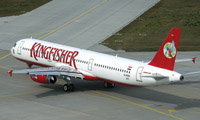Year End Review: India
Agony for Kingfisher
December 1st 2012
It’s not been a good year for India’s airline industry. Nobody has come off worse than Kingfisher Airlines whose depleted fleet at press time was grounded and its licence suspended by the regulator, the Directorate General of Civil Aviation. Read More »
 |
| Kingfisher Airlines: from second biggest to smallest of India’s six largest carriers in a matter of months |
The airline’s fall was spectacular. It started the year with 64 aircraft, but by February only 22 were flying, a figured reduced to nine by October as Kingfisher limped from financial crisis to financial crisis. As the year progressed, about 30 planes were reclaimed by lessors as bills remained unpaid.
There were strikes and walk-outs by staff, many of whom had gone unpaid for months. Striking engineers refused to certify the airworthiness of its remaining fleet of jets.
A year ago, Kingfisher was India’s second largest operator. By August, its market share had plummeted to just 3.2%, the smallest among India’s six largest airlines.
The Indian government’s long-awaited decision to approve foreign direct investment (FDI) in the country’s airlines could have come too late to save Kingfisher. Ironically, founder and chairman, Vijay Mallya, had led the lobbying campaign to force New Delhi’s hand to make the change.
Under the new rules foreign carriers will be allowed to take up to 49% of an Indian operator. However, interested parties will have to receive clearances from India’s Foreign Investments Promotions Board and the aviation ministry. Also, 75% of the local airline’s directors will have to be Indian nationals.
The big question now is will overseas carriers come to the party? Last year, the combined losses of Indian airlines amounted to $2.5 billion and the same amount of red ink is expected for 2012. Only low-cost operator, Indigo, made money in 2011.
Most industry observers and analysts rate SpiceJet as the best bet among India’s carriers for investment. The carrier’s chief executive, Neil Mills, has expressed interest in selling equity to a foreign carrier if the offer was right.
Meanwhile, Orient Aviation reported in October that executives of Gulf carrier, Etihad Airways, had had talks with Mumbai-based Jet Airways’ chairman, Naresh Goyal, and chief executive, Nikos Kardassis.
Sources said Etihad was interested in a minority stake.
The greatly over-staffed and heavily indebted national carrier, Air India (AI), must have thought many of its problems would have been resolved five years ago when it merged with leading domestic operator, Indian Airlines (IA). Wrong.
IA was in the news again this year when its former pilots at AI found themselves at the centre of a strike by the Indian Pilots Guild. The guild was unhappy with the B787 training schedule, which, they alleged, favoured ex-pilots from IA.
As many as 300 pilots went on strike or sick leave. AI’s B777 fleet was grounded and the carrier was said to have lost as much as $60 million in the multi-week strike. In response, the government dismantled the pilots’ guild.
In September, 400 AI pilots went on mass “sick leave” about 25%-50% cuts in productivity-linked bonuses. The action led to many flight cancellations, including international operations.
Jet Airways pilots also went on strike in mid-year over the sacking of two of their colleagues. A week later they returned to work when the pilots were re-instated.
AI’s huge financial burden was made somewhat lighter in May when the Indian government agreed to another life-saving injection of funds - $5.8 billion through to 2020, including $1.3 billion in the current financial year.
They are not alone. India’s carriers are said to be collectively in $20 billion of debt.
Before AI was granted its handout, the government had to agree to turnaround and financial restructuring plans.
The airline will take delivery of 27 B787s under a sale-leaseback arrangement. It will also spin off its maintenance, repair and overhaul and ground handling divisions, which will be run as profit centres.